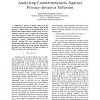Free Online Productivity Tools
i2Speak
i2Symbol
i2OCR
iTex2Img
iWeb2Print
iWeb2Shot
i2Type
iPdf2Split
iPdf2Merge
i2Bopomofo
i2Arabic
i2Style
i2Image
i2PDF
iLatex2Rtf
Sci2ools
ICSEA
2006
IEEE
2006
IEEE
Analysing Countermeasures Against Privacy-Invasive Software
User privacy is widely affected by the occurrence of privacy-invasive software (PIS) on the Internet. Various forms of countermeasures try to mitigate the negative effects caused by PIS. We use a computer forensic tool to evaluate an anti-spyware tool, with respect to found PIS over a four years period. Within the anti-spyware tool PIS was slowly identified, caused classification problems, and formely classified PIS were sometimes excluded. Background information on both PIS and countermeasure techniques are also presented, followed by discussions on legal disputes between developers of PIS and vendors of countermeasures.
| Added | 11 Jun 2010 |
| Updated | 11 Jun 2010 |
| Type | Conference |
| Year | 2006 |
| Where | ICSEA |
| Authors | Martin Boldt, Bengt Carlsson |
Comments (0)

